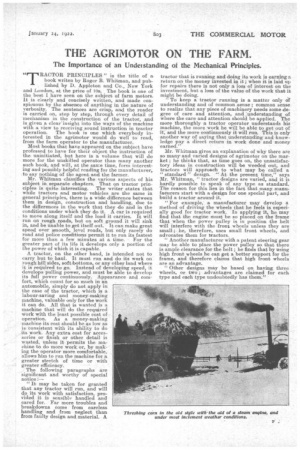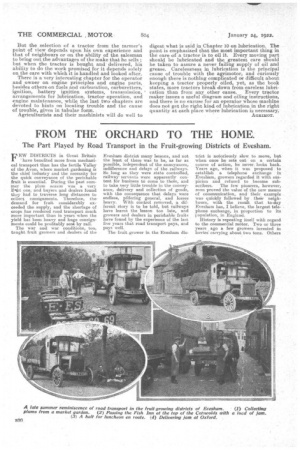THE AGRIMOTOR ON THE FARM.
Page 25

Page 26

If you've noticed an error in this article please click here to report it so we can fix it.
The Importance of an Understanding of the Mechanical Principles.
"TRACTOR PRINCIPLES" is the title of a, book writ,en by Roger B. Whitman, and published by D. Appleton and Co., New York and London, at the price of les. The book is one of the best I have seen on the subject of farm motors. It is clearly and concisely written, and made conspicuous by the absence of anything in the nature of verbosity. The sentences are crisp, and the reader is carried on, step by step, through every detail of mechanism in the construction of the tractor, and is given a clear' insight into the ways of the machine with a view to receiving sound instruction in tractor operation. The book is one which everybody interested in the agrimotor would do well to read, from the farm operator to the manufacturer.
Most books that have appeared on the subject have professed to have for their object the instruction of the uninitiated', but here is a volume that will do more for the unskilled operator than many another such book, and will, at the same time, form interesting and possibly helpful reading for the manufacturer, to say nothing of the agent and the farmer.
Mr. Whitman classifies the various aspects of his subject in separate chapters. That on tractor principles is quite interesting. The writer states that while tractors and motor vehicles are the same in general principles, there is a wide difference between them in design, construction and handling, due to the differences in the work that they do and in the conditions under which they do it.A car is required to move along itself and the load it carries. It will run on rough roads, but on soft ground it will sink in, and be unable to get itself out. It can make great speed over smooth, level roads, but only rarely do road and police conditions permit it to run its fastest for more than a few minutes at a, time. For the greater part of its life it develops only a portion of the power of which it is capable.
A tractor, on the other hand, is intended not to carry but to haul. It must run and do its work on rough hill sides, soft bottoms, or any other land where it is required to go. Instead of developing speed, it develops pulling power, and must be able to develop its full power continuously. Appearance and comfort, which count for so much in an automobile, simply do not apply in the case of the tractor, which is a labour-saving and money-making machine, valuable only for the work it can do. All that is wanted is a machine that will do the required work with the least possible cost of operation. As a money-making machine its cost should be as low as is consistent with its ability to do its work. Any extra cost for accessories or finish or other detail is wasted, unless it permits the machine to do more work or, by making the operator more comfortable, allows him to run the machine for a greater stretch of time or with greater efficiency. The following paragraphs are significant and worthy of special notice :— "Itmay be taken for granted that any tractor will run, and will do its work with satisfaction, provided it is sensibly handled and cared for. Far more troubles and breakdowns come from careless handling and from neglect than from faulty design and material. A
tractor that is running and doing its work is earning a return on the money invested in it ; when it is laid up for repairs there is not only a loss of interest on the investment, but a loss of the value of the work that it might be doing. To keep a tractor running is a matter only a understanding and of common sense ; common sense to realize that any piece of machinery needs some degree of care and attention, and understanding of where the care and attention should be applied. The more thoroughly a tractor operator understands his machine, the more work he will be able to get out of it, and the more continuously it will run. This is only another way of saying that understanding and knowledge pay a direct return in work done and money earned'."
Mr. Whitman gives an explanation of why there are so many-and varied designs of agrimotor on the market ; he thinks that, as time goes on, the unsatisfactory ideas in construction will be weeded out, and tractors will approach to what may be called a " standard" design. "At the present time," says Mr. Whitman, "tractor designs are varied, and it is hardly possible to speak of any type as standard. The reason for this lies in the fact that many mannfaeurers start with a design for one special part, and build a tractor around it.
"For example, a manufacturer may develop a method of driving the wheels that he feels is especially good for tractor work. In applying it, he may find that the engine must be so placed on the frame that when the power pulley is in position the belt will interfere with the front wheels unless they are small;. he, therefore, uses small front wheels, and advocates them for tractors.
"Another manufacturer with a patent steering gear may be able to place the power pulley so that there is ample clearance for the belt ; he finds that by using high front wheels he can get a better support for the frame, and therefore claims that high front wheels are an advantage.
"Other designs may be based on having three wheels, or two ; advantages are claimed for each type and each type undoubtedly has them." But the selection of a tractor from the farmer's point of view depends upon his own experience and that of neighbours or on the ability of the salesman to bring out the advantages of the make that he sells ; but when the tractor is bought and delivered, his ability to do the work promised for it depends solely on the care with which it is handled and looked after.
There is a very interesting chapter for the operator and owner on engine principles and engine parts, besides others on fuels and carburation, carburetters, ignition, battery ignition systems, transmission, arrangements for lubrication, tractor operation, and engine maintenance, while the last two chapters are devoted to hints on locating trouble and the cause of trouble, given in tabular form.
Agriculturists and their machinists -will do well to
digest what is said in Chapter 10 on lubrication. The pomt is emphasized that the niest important thing in the care of a tractor is to oil it. Every moving part should be lubricated and the greatest care should be taken to assure a never failing supply of oil and grease. Carelessness in lubrication is the principal cause of trouble with the agrin2otor, and curiously enough there is nothing complicated or difficult about keeping a tractor properly oiled, yet, as the book states, more tractors break down from careless lubrication than from any other cause. Every tractor maker issues a useful diagram and oiling instructions, and there is no excuse for an operator whose machine does not get the right kind of lubrication in the right quantity at each place where lubrication is necessary. AGRIBIOT.






























